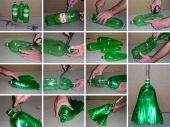I need a bit of advice and a load of ideas on how to proceed with my
pond, especially sealing it!
This
pond was supposedly dug to provide the clay/mud to point the stonework of the house, many years ago. It fills up after heavy rains, and then dries out again during the spring, leaving it bone dry over the summer.

My other half has always wanted to do something with it, and this year we had our chance.

A friend of ours has dug the area out to enlarge and deepen the pond. It's still bone dry though...

Digging had to stop while an
ants' nest was excavated - you can see the shale that has been dug out, which has now been put on the track to fill some of the pot-holes.

This is the soil profile, which is typical of our
land - 8" of soil above rock. The rock here is shale, which is fairly easy to dig through, assuming you have a friend with a JCB.

As you can see, there's only about a spade-depth of soil, which dries out totally by July, which is great fun learning to grow stuff in...
I get the impression that most 'naturally built' ponds are dug in soil, not rock, and you can use the soil to form a natural liner, either by squashing it into place imitating pigs wallowing, or by shaking everything up and hoping that the clay will settle out first and form a sealed layer. Bearing in mind that the pond is empty and there's precious little soil of any description, I can't see that that's going to work.
My other half is thinking of lining this one with
concrete, but we also have a ten acre strip of land below the farm, with a very similar soil profile, that we may be able to talk our friend into digging ponds in for us over the next few years. I'm pretty sure that after doing a concrete liner on this, rather small, pond that my other half will be much more open to more 'natural' suggestions of persuading the
water to stay in the pond for as long as possible.
But I need a few suggestions?

Anyone have any
experience with ponds like this?














































